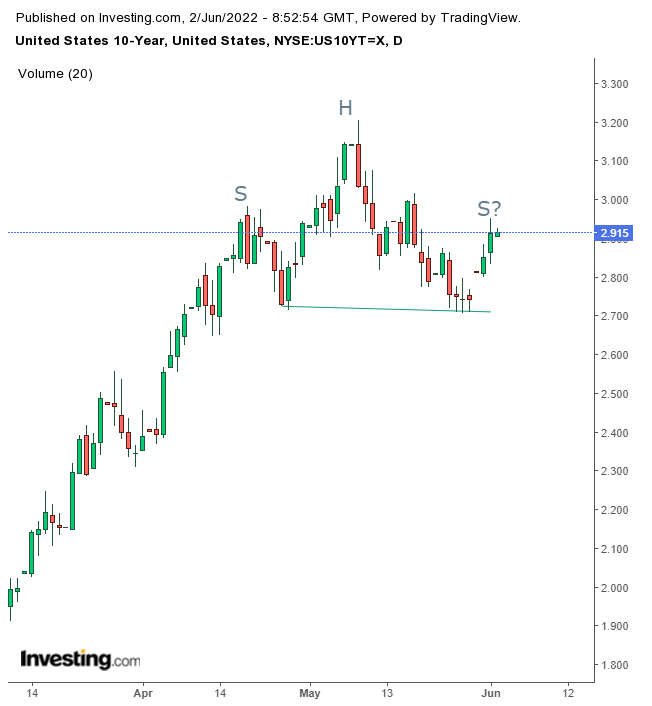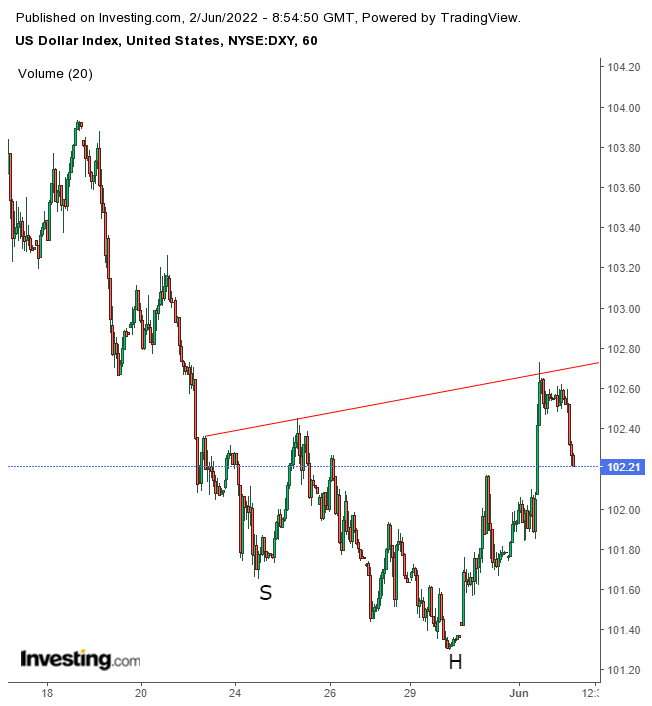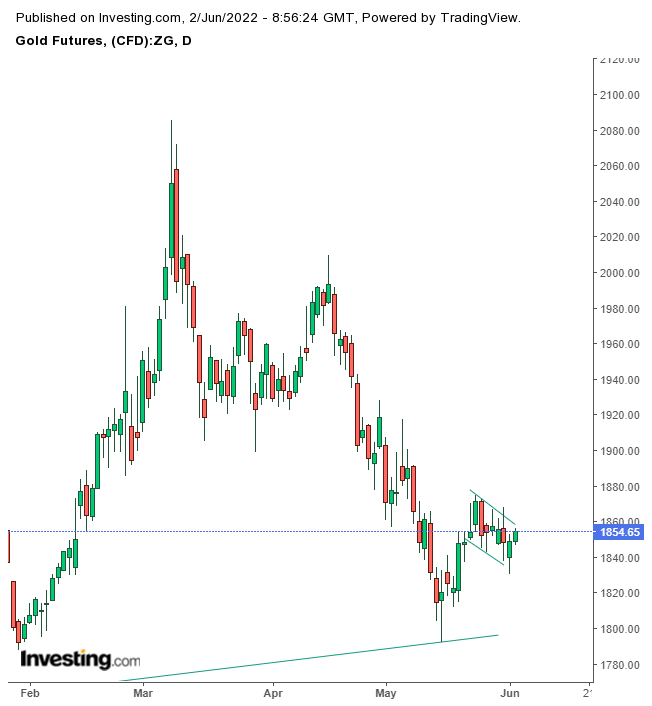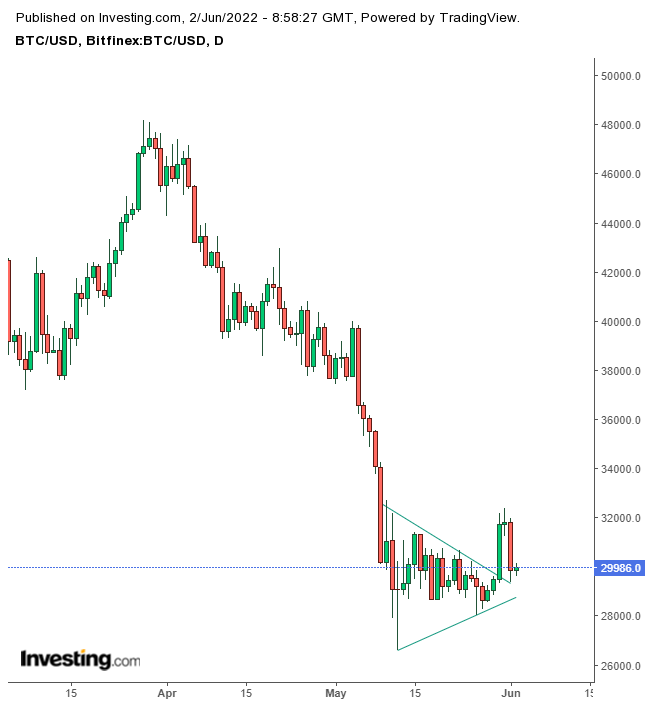- Investors buy the dip after yesterday's slump despite better-than-expected economic data
- JP Morgan's Dimon warns of economic turmoil
- US dollar slides
- US nonfarm payrolls figures are released on Friday
- The US unemployment rate is published on Friday
- On Friday, ISM non-manufacturing PMI is printed
- The MSCI Asia Pacific Index fell 0.8%
- The MSCI Emerging Markets Index fell 0.8%
- The euro rose 0.3% to $1.0678
- The Japanese yen fell 0.2% to 129.80 per dollar
- The offshore yuan fell 0.2% to 6.6811 per dollar
- The British pound rose 0.5% to $1.2548
- Germany's 10-year yield advanced one basis point to 1.20%
- Brent crude fell 2.4% to $113.47 a barrel
- Spot gold rose 0.5% to $1,856.57 an ounce
Key Events
On Thursday, US futures on the Dow Jones, S&P 500, NASDAQ 100, and Russell 2000 advanced alongside European stocks as traders bought a two-day dip. Markets were considering the Fed's persistent optimism versus warnings of economic woes from Jamie Dimon, CEO of JP Morgan.
A retreat in oil prices may have helped traders side with the Fed's more palatable view.
Global Financial Affairs
While all US futures were in the green this morning, contracts on the tech-heavy NASDAQ 100 outperformed, almost doubling the performance of contracts on the Dow, which represent cyclicals and defensive stocks. Technology has been one of the main leaders in market rallies and slumps recently and today may be no different. However, the outlook from Dimon—cautioning that investors must "brace themselves" for the upcoming "financial hurricane"— is in stark contrast to comments from the US Federal Reserve, which makes us think that today's rally in tech is indicative of market complacency.
We have previously pointed out that some market commentators consider part of the Fed's role to be that of a stock market cheerleader. The most recent example was when Fed members insisted that rising US inflation was "transitory" and that it would not impact the economy since it would ultimately settle.
This was completely opposite of warnings from some prominent economists at the time. Is this an example of the Fed using rhetoric to ease bearish concerns?
In Europe, the STOXX 600 Index gained on Thursday, driven by a strong performance in construction and consumer shares. Energy stocks underperformed on reports that Saudi Arabia will increase its oil production to compensate for the phased ban of Russian oil due to additional sanctions from Europe. UK markets are closed in celebration of Queen Elizabeth's Platinum Jubilee.
Asian stocks closed lower, with one exception. China's Shanghai Composite, which was the only bright spot in the region, rose 0.4%, as the reopening of the economy there, due to the removal of coronavirus restrictions, sparked a buying dip. Conversely, Hong Kong's Hang Seng dropped 1% as its citizens were still subject to stringent COVID-19 lockdowns.
Yesterday, US shares started June on the back foot, extending a decline after stronger-than-expected economic data failed to calm investors' concerns on inflation. Both the S&P 500 and the NASDAQ 100 fell about three-quarters of a percent after US manufacturing activity surprised to the upside and an exceptionally high number of job openings reinforced the outlook for a faster pace of tightening.
Treasuries continued to fall which propelled yields on the 10-year note above 2.9%.

Technically, however, there is still a chance for an H&S top if rates fall below 2.7%.
The dollar also declined, paring a two-day advance.

The greenback may be bottoming, developing a potential H&S bottom, complete with an upside breakout, probably above 103.00
Gold rose for the second day.

Although this advance can be attributed to dollar weakness, the yellow metal moved higher yesterday, despite dollar strength. This reinforces the scenario of a Falling Flag, bullish after bouncing off the uptrend line.
Bitcoin was little changed after yesterday's dramatic drop which mirrored Monday's surge.

The price jumped and landed on the very top of a pennant. We expected it to be bearish, after the preceding drop, but its support increases the chances of a short-term bounce before resuming a slide, which is our long-term outlook for the cryptocurrency.
The report of potentially increased oil supply from Saudi pushed the price below a support area.

It fell below its steeper (green) Rising Channel as it slipped below the trendline that connected the highs from March through April.
